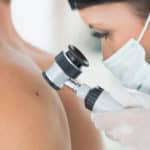What You Need to Know About Mohs Treatment
Your skin protects you from outside physical and chemical agents; your skin also protects you from heat, injury, sunlight and infection while controlling body temperature and regulating body fluids. Widely considered the most common cancer in the United States, skin cancer is the growth and progression of abnormal skin cells. Like other types of cancer, skin cancer progresses through various stages of severity. Stage 0 is the least severe and most curable stage; it is when cancer cells are confined to the epidermis and have not yet spread to other parts of the body. Meanwhile, Stage 5 is the final stage, as well as the most severe and difficult to cure. This stage occurs when cancer cells spread beyond the epidermis into distinct organs such as the liver, lungs and brain.
Among the various treatments use to combat skin cancer, Mohs treatment is the most effective as opposed to chemotherapy, radiation, and immunotherapy. The American Society for Mohs Surgery reports that Mohs surgery provides five-year cure rates, approaching nearly 99% for new cancers and 95% for recurrent cancers. The procedure was developed in 1930 by Frederic E. Mohs, M.D. and refined by new experts for maximum effectiveness. Mohs treatment is designed to identify and remove effected tissue while leaving the surrounding area intact. Furthermore, Mohs treatment minimizes the risk of recurrence while eliminating the costs of larger skin surgeries.
What Does The Mohs Procedure Entail?
Mohs treatment does not require anesthesia and is a same day procedure, which means the patient will be able to leave that day. The entire preparation and procedure can last anywhere between 1 to 5 hours depending on the severity and stage of the cancer. During the procedure dermatologists numb healthy skin around the cancer cells with an anesthetic. The cancerous tissue is removed then immediately frozen and stained in the doctor’s office.
After removal, the entire bottom and outer edges of the tissue layer are examined under a microscope. Dermatologists remove an additional thin layer of tissue from the area where cancer cells remain if detected under a microscope. The process of microscopic examination and removal tissue continues until dermatologists can no longer detect cancer cells under the microscope.
Mohs Post-Surgical Healing Process
Unlike chemotherapy and radiation, Mohs surgery minimizes the psychological and physical impact a patient may face. Keep in mind that the patient may have an open wound, a skin graft, or stitches after the surgery; therefore, the wound requires adequate healing time to minimize the risk of infection. Dermatologists will prescribe antibiotics and pain relievers to reduce any discomfort.
Applying a cold pack to the area wound area for about 15 minutes daily will help minimize swelling. Your dermatologist will also instruct you on hygiene habits such as when you can bathe and how to clean the wound. For a successful Mohs surgery recovery, following your dermatologist’s instructions will help protect your surgical wound from infection, minimize the risk of permanent scars, and keep your body healthy.
An Effective Cancer Treatment Option
Finding an effective treatment is important when battling skin cancer. The American Academy of Dermatology estimates that nearly 9,500 people in the United States are diagnosed with skin cancer daily, and approximately one in five Americans will develop skin cancer in their lifetime. Luckily, skin cancer is highly treatable if detected and treated early. The Skin Cancer Foundation recommends that everyone should practice monthly head-to-toe self-examination of their skin so that they can find any new or changing lesions that may be cancerous.
For more information about Mohs treatment or to schedule a cancer screening, contact Short Hills Dermatology today!





